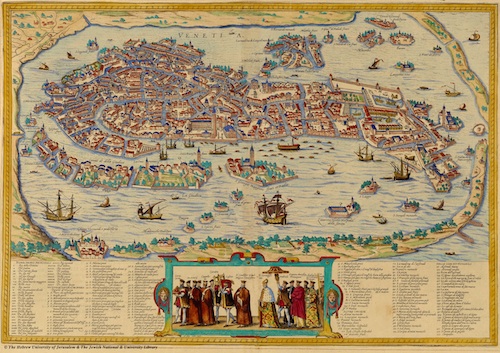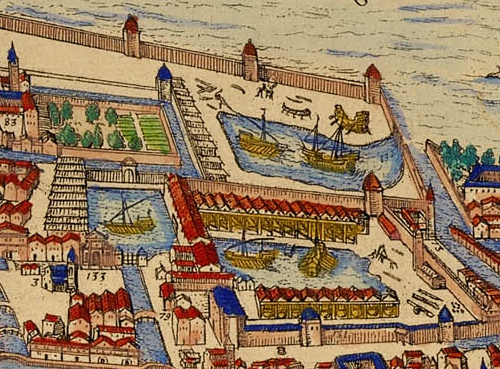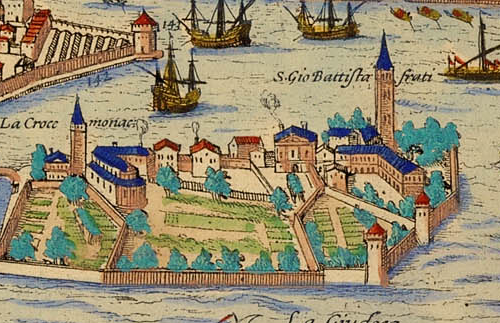
(Image credit: The Hebrew University of Jerusalem)
I was reading Galileo the other day when I became interested in Renaissance Venice (the place had sublime music, visual arts, and all the culture that comes with the great flowerings of these things), and a few Google searches later I found myself staring at the map above for about 20 minutes. (Click here for a larger copy.) The map was drawn by Bolognino Zaltieri in 1565. Now, it’s already allergy season here in central Texas and I admit that I feel as though I’m on allergy meds without having even taken any, so my fascination with the map could be due to various things beyond my own intellect, however, you’ve got to admit – this map is awesome. It’s just crazy to imagine living amongst one of those waterways several hundred years ago. How about all the bridges? And do you notice that a pedestrian going from one mini-island to another might have to plan their trip in advance, as not every mini-island is connected to its peers? And then, of course, you wonder how it was all built without the aid of gasoline-powered construction tools. I thought I’d share it all with you. It’s just mesmerizing how a city built upon a marsh contains so many things, and how a mapmaker was able to portray segmented happenings and city life.

(Image credit: The Hebrew University of Jerusalem)
I think my favorite aspect of this map is detailed above. This is presumably the section of Venice that was preserved for shipbuilding and maintenance. Venice did have a good navy back in the day, and seeing this image of Renaissance Italy makes me think of those space stations in Star Trek where you sometimes see spacecraft under construction. Like those space stations in Star Trek, where the docks are just extensions of man-made machine out onto space, here the city takes advantage of the fact that it’s inundated by water. Elsewhere, it’s fun to notice all the churches. It’s almost as if every few houses has their own church. St. Mark’s Square is largely as it looks today. It’s fun to look south at the Dorsoduro and see all the small vegetable plots – not what you’ll find there today.

(Image credit: The Hebrew University of Jerusalem)
Galileo’s biggest contribution to the history of thought was his realization that the conditions found in a system tend to work irrespective of the conditions of that system. So, in other words, just because the Earth might be speeding around the Sun doesn’t mean that we on Earth will feel the effects of that movement. Einstein obviously built upon this later in his Theory of Relativity. Looking at this map of Renaissance Italy, it kind of makes sense that someone living there would have come up with such an “inertial system”. In the map waters and time pass throughout Venice, and unmoved, Venice goes on being a cultural capital. Obviously, Galileo’s thoughts and discoveries owe much to technological innovation, new communications technologies (the post!), and the general mingling of ideas, but looking at this map of Venice, one can easily see how he might have been able to develop an aesthetic in such a place.
It sure is an interesting map to look at and daydream at for a bit, with or without allergies.



Recent comments
2 years 29 weeks ago
2 years 44 weeks ago
2 years 44 weeks ago
2 years 50 weeks ago
3 years 4 weeks ago
3 years 4 weeks ago
3 years 4 weeks ago
3 years 6 weeks ago
3 years 6 weeks ago
3 years 6 weeks ago